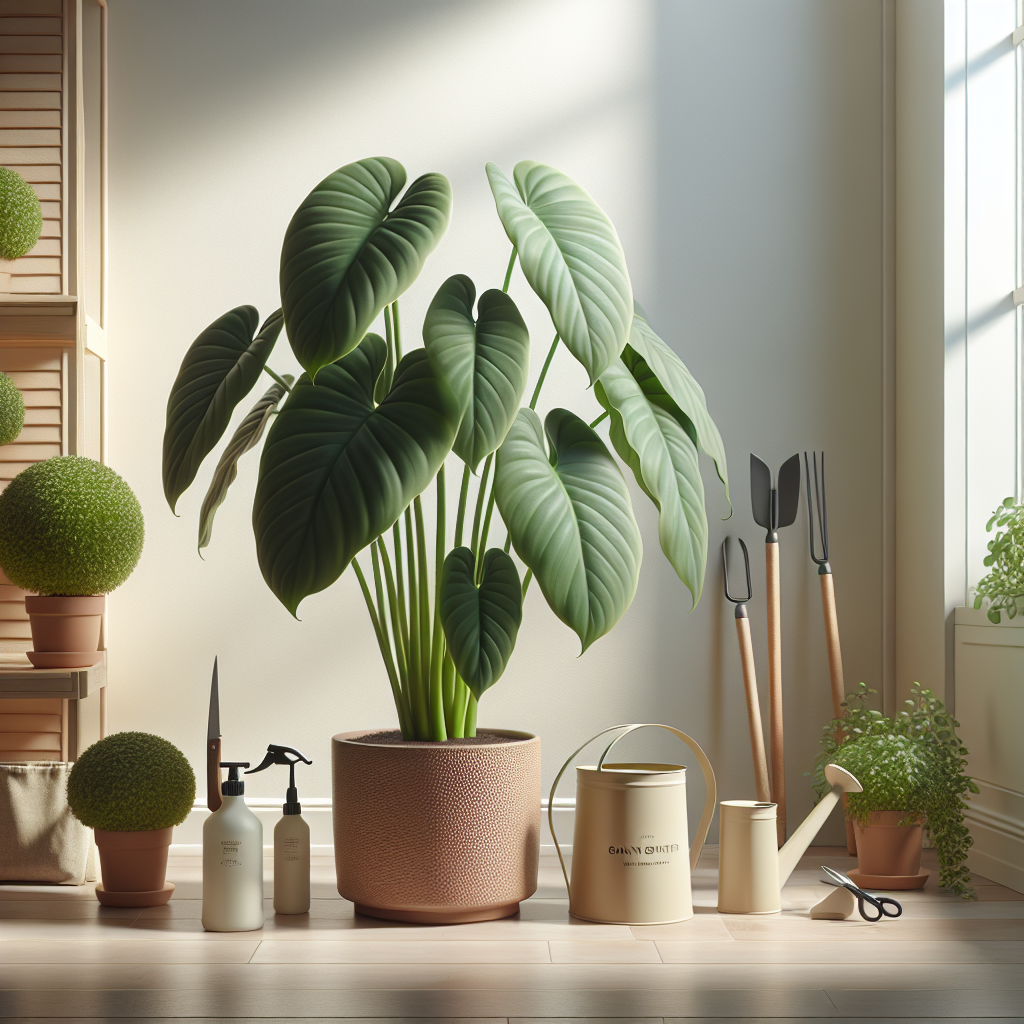Caring for an Indoor Elephant Ear Plant: Best Practices
Updated June 8, 2024 at 12:57 pm

Elephant Ear Plant Overview
- Pet Friendly: Use caution around pets as Elephant Ear plants can be toxic if ingested.
- Light Requirements: Prefers bright, indirect light but can tolerate partial shade.
- Watering: Regular watering is crucial, the soil should be kept consistently moist.
- Humidity: Thrives in a high humidity environment; misting the leaves can help.
- Temperature: Prefers warm conditions, ideally between 65-75°F (18-24°C).
- Difficulty: Moderate care is required, making it a good choice for plant enthusiasts with some experience.
The Right Potting Mix and Fertilizers for Thriving Elephant Ears
Caring for your indoor Elephant Ear plant begins with understanding its native habitat – the tropical rainforests. To recreate this environment, you need well-draining soil that retains moisture without becoming waterlogged. A mix of peat, pine bark, and perlite can provide the perfect balance. This mimics the forest floor, offering support and nutrition to your plant.
When it comes to fertilizers, a balanced liquid fertilizer can work wonders during the growing season. One popular choice is the Miracle-Gro Water Soluble All Purpose Plant Food. According to reviews, gardeners have found that regular feedings with this fertilizer encourage lush and healthy growth. However, always ensure to follow the application instructions, as too much can harm your plant.
- Encourages healthy growth
- Easy to apply with water
- Well-balanced N-P-K ratio
- Can cause fertilizer burn if overused
- Not organic
Find This and More on Amazon
Navigating Watering Practices for Healthy Elephant Ear Plants
One of the trickiest parts of caring for an Elephant Ear is getting the watering right. The soil should typically be moist to the touch, but not soggy. Over-watering can lead to root rot, a common issue that some plant lovers might have faced. On the flip side, under-watering will cause the plant to wilt and its leaves to turn brown on the edges.
For those unsure if they’re watering correctly, a soil moisture meter like the XLUX T10 Soil Moisture Sensor Meter can be an invaluable tool. This device has been praised for taking the guesswork out of watering, with a clear and simple display showing moisture levels. A tool like this ensures that you’re providing just the right amount of water for your Elephant Ear plant.
- Easy to read moisture levels
- Does not require batteries
- Helps prevent over- and under-watering
- Sensor may be delicate; handle with care
- May not be as accurate in very dense soil
Find This and More on Amazon
Combatting Common Pests and Diseases in Elephant Ear Plants
Even with the best care, your Elephant Ear can encounter pests and diseases. Spider mites, aphids, and mealybugs can all find a home amongst the broad leaves of your plant. It’s said that people often use neem oil, such as the Garden Safe Neem Oil Extract, as an effective organic solution. Neem oil has been reported to combat pests without harming the plant or beneficial insects when used as directed.
As for diseases, keep an eye out for the telltale signs of root rot or fungal infections. This could include discolored leaves or a mushy base. Make sure you have good air circulation around the plant to prevent fungal growth, and if you suspect root rot, inspect the roots and remove any that are affected. Using a fungicide can also help prevent spread.
- Organic and safe for use around children and pets
- Effective against a variety of pests
- Can also help with fungal diseases
- Can have a strong odor
- Needs to be applied regularly for best results
Optimal Lighting Conditions To Promote Elephant Ear Growth
Getting the lighting right is crucial for the well-being of your Elephant Ear plant. These plants are accustomed to bright, dappled sunlight of the rainforest canopy. Therefore, you should aim to replicate these conditions as closely as possible. Place your plant in a location where it can receive ample indirect light. If the light is too direct or intense, it can scorch the leaves, so use a sheer curtain to filter the light if needed.
If you don’t have enough natural light, you could consider a grow light. Many plant enthusiasts have found success with the GE BR30 Full Spectrum LED Grow Light Bulb. It provides the balanced light required for healthy plant growth without the risk of sun damage. This bulb emits low heat and can fit into a standard light socket, making it a user-friendly option for indoor gardeners.
- Full spectrum lighting suitable for all growth stages
- Energy-efficient and long-lasting
- Fits standard sockets and is easy to install
- May not be as effective for large plants without multiple bulbs
- More expensive than regular bulbs
Find This and More on Amazon
Boosting Humidity for Your Elephant Ear Plant
Elephant Ear plants crave humidity. Often, the air in our homes is too dry for these tropical natives. One simple way to increase humidity is to group plants together, as they naturally release moisture. Alternatively, using a pebble tray filled with water under the plant’s container can also help to introduce more moisture into the air as the water evaporates.
For a more consistent humidity solution, you might want to invest in a humidifier. The LEVOIT Classic 100 Ultrasonic Cool Mist Humidifier is well-reviewed for being quiet and effective. This device has helped many plant owners maintain the ideal humidity levels for their indoor garden. Moreover, it features a large capacity tank that ensures long-lasting, continuous operation.
- Ultrasonic technology operates quietly
- Large water tank reduces the need for frequent refills
- Doubles as a health benefit for households
- Initial cost may be higher than other humidifying methods
- Requires regular cleaning to prevent mold and bacteria
Find This and More on Amazon
Pruning and Maintenance to Keep Elephant Ears Flourishing
Pruning is an important aspect of Elephant Ear plant care. It not only maintains the aesthetic appeal but also encourages healthier, more robust growth. As leaves age, they may turn yellow or brown. Removing these promptly will redirect your plant’s energy to new foliage. Always use a clean, sharp pair of pruning shears to minimize damage and prevent disease transmission.
It’s not uncommon for experienced gardeners to use the Fiskars Softgrip Bypass Pruning Shears for their comfort and precision. These shears are designed for non-stressful pruning, and many users testify to their durability and ease of use. Keeping a pair on hand will ensure you’re always ready for necessary maintenance tasks.
- Ergonomic soft-grip handles
- Precision-ground steel blades
- Easy-open lock protects the blades during storage
- Blades may require sharpening over time
- Not suitable for very thick stems or branches
Find This and More on Amazon
Understanding and Reacting to Leaf Browning in Elephant Ears
When the leaves of your Elephant Ear plant start to brown, it’s a signal that the plant is stressed. The browning of leaves could be due to a variety of reasons like low humidity, over-fertilizing, or inadequate watering. If you spot browning leaves, it’s essential to assess your care routine and the environment. Sometimes, simply adjusting the watering schedule or moving the plant to a more suitable location is enough to reverse the issue.
If environmental changes don’t seem to solve the problem, consider whether a nutrient deficiency might be the cause. Browning can sometimes indicate a lack of essential minerals like magnesium or potassium. Adding a supplement to the soil, such as Epsom salt or a potassium-rich fertilizer, could nourish the plant back to health. Be sure to test the soil with a kit before adjusting fertilizer levels.
Repotting Elephant Ears for Optimal Growth
Elephant Ear plants can grow quite large, and as such, they frequently need to be repotted. Generally, repotting is necessary when you see roots growing out of the bottom of the pot or if the plant’s growth seems stunted. Choose a pot that is 2-3 inches larger than the current one, with adequate drainage holes to prevent waterlogging.
When repotting, it’s vital to handle the roots gently to prevent shock. You can utilize specialized potting mix that’s formulated for tropical plants, which often contains the right blend for aeration and moisture retention. The Espoma Organic Potting Mix is a favorite among gardeners for its natural ingredients and the boost it provides to plant growth.
- Contains a rich blend of organic materials
- Promotes strong root systems
- Myco-tone formula for better moisture retention
- May be pricier than non-organic alternatives
- Could attract gnats if too moist
Find This and More on Amazon
Maximizing Growth During the Active Season
Elephant Ear plants have a period of active growth during the warmer spring and summer months. During this time, it’s essential to provide the plant with all it needs to flourish. This includes consistent watering, high humidity, and additional feedings with a nutrient-rich fertilizer.
During growth periods, consider increasing the frequency of fertilization with a slow-release formula, like Osmocote Smart-Release Plant Food. This specific fertilizer is known for evenly distributing nutrients over time, which can help the Elephant Ear sustain lush, vibrant leaves. Remember, it’s crucial to avoid over-fertilization, as doing so can cause more harm than good, leading to salt build-up and root damage.
- Provides continuous nutrition for up to 4 months
- Easy to apply and work into the soil
- Contains essential nutrients for leafy growth
- Can be harmful to water systems if runoff occurs
- Not organic, some gardeners prefer plant-based fertilizers
Find This and More on Amazon
Addressing Elephant Ear Dormancy in Winter
As the days shorten and temperatures drop, Elephant Ear plants enter a period of dormancy. This is a natural part of the plant’s lifecycle, and during this time, growth slows, and the plant may even lose some leaves. In preparation for dormancy, you should reduce watering and stop fertilizing. It’s a time for the plant to rest, and overwatering during dormancy can lead to root rot.
Indoor gardeners should consider moving the Elephant Ear to a cooler part of the house but still above freezing temperatures. Ensure it has enough light to sustain it through the winter months. Take this dormancy period as an opportunity to inspect the plant for any pest issues or general health concerns to address before the next growing season begins.
Final Tips for the Aspiring Elephant Ear Plant Owner
Caring for an Elephant Ear plant can be incredibly rewarding. With its large, dramatic foliage, it’s a conversation starter and a beautiful addition to any interior space. Remember to monitor the moisture levels, use the right soil mix, manage light and humidity appropriately, and nurture your plant with regular feeding and care.
Last but not least, enjoy the process! Plant care is not just a way to beautify your space, but it’s also gratifying and can be deeply meditative. Connect with local plant communities or online groups for extra support and knowledge-sharing. With these best practices, you’ll be well-equipped to ensure your indoor Elephant Ear plant thrives in its environment, bringing a touch of the tropics to your home.
Shop more on Amazon

